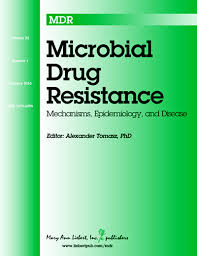Antimicrobial usage and detection of multidrug-resistant Staphylococcus aureus, including methicillin-resistant strains in raw milk of livestock from northern Kenya. Microbial Drug Resistance.
23/02/21 08:24AM
Mwenga, I., Aboge, G.O., Mitema, E.S., Obiero, G., Ngaywa, C., Ngwili, N., Wamwere, G., Wainaina, M. and Bett, B./. 2021.
Abstract/Description
The association of antimicrobial usage (AMU) with prevalence of antimicrobial-resistant (AMR) Staphylococcus aureus, including methicillin-resistant S. aureus (MRSA) in livestock raw milk consumed by pastoralists in Kenya remains unclear. We investigated the relationship between AMU and emergence of multidrug-resistant (MDR) S. aureus, including MRSA in raw milk of livestock. AMU data were obtained using sales records from veterinary pharmacies. S. aureus was isolated from 603 milk samples from various livestock species, including sheep, goat, cow, and camel reared in Isiolo and Marsabit counties in Kenya. Resistant phenotypes and genotypes were determined by disc diffusion and molecular methods, respectively. Correlation between AMU and occurrence of resistance was determined by Pearson's correlation coefficient (r) method. The consumption of various antimicrobial classes were as follows; 4,168 kg of oxytetracycline, 70 kg of sulfonamides, 49.7 kg of aminoglycosides, 46 kg of beta-lactams, 39.4 kg of macrolides, and 0.52 kg for trimethoprim. The S. aureus isolates were mainly resistant to tetracycline (79%), ampicillin (58%), and oxacillin (33%), respectively. A few isolates (5–18%) were resistant to clindamycin, cephalexin, erythromycin, kanamycin, and ciprofloxacin. Most of the MDR-S. aureus isolates were MRSA (94%). The genetic determinants found in the AMR isolates included tetK/tetM (96.5%/19%) for tetracycline, blaZ (79%) for penicillin, aac (6′)/aph (2′′)/aph (3′)-IIIa (53%) for aminoglycosides, mecA (41%) for oxacillin, and msrA/ermA (24%/7%) for macrolides. Oxytetracycline usage was correlated to tetK/tetM (r = 0.62/1) detection, penicillins to mecA/blaZ (r = 0.86/0.98), aminoglycoside to aac (6′)/aph (2′′)/aph (3′)-IIIa (r = 0.76/−13), and macrolide usages for detection of ermA/msrA (r = 0.94/0.77). AMU appeared to be associated with occurrence of MDR-SA and the tetM detection. Consumption of raw milk contaminated with MRSA could pose a serious public health risk in pastoral communities in northern Kenya.
Permanent link to cite or share this item: https://hdl.handle.net/10568/110223
DOI: https://doi.org/10.1089/mdr.2020.0252
DOI: https://doi.org/10.1089/mdr.2020.0252





